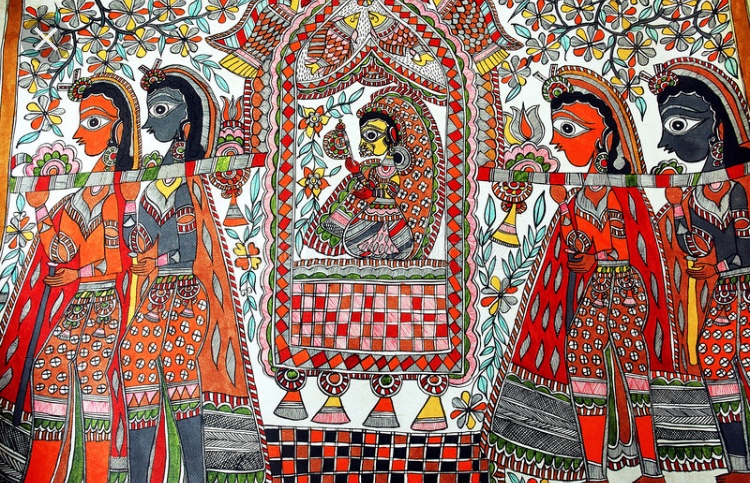MADHUBAN -LEELA
MADHUBAN -LEELA
The journey of art work with depiction of culture and tradition deeply en rooted within .It all began with the wall art work which was intimate to the family to a paper work which is known by world.
 |
For most of its life, Madhubani or Mithila painting was an intimate art form, meant for a small audience even within a family. Making this art was an intrinsic part of a woman’s household chores: tend the hearth, sweep the yard, paint the walls,these spaces became the narration of the stories and added more value to these spaces ,instead of making these walls plain women chose them to depict their life story - A mother-in-law would welcome the bride marrying into her home with precisely drawn geometric patterns on the walls of her new bed chambers or khober-ghar. These paintings came to be known as khober and besides being things of beauty, they were believed to have the power to enhance fertility.These stories made the walls and spaces more personalized and happening for the residents .The colors used were bright and made from natural dyes namely indigo ,yellow,red etc.
This art translated and converted the space into place for a person who never belonged to that space.The impact that a small art work created in a family mattered the most gave the artwork its importance .Architecture is all about converting space into place and making a user comfortable and creating memories .This artwork not only helped in that but also the protected the walls .As every occasion was conveyed through art on walls a constant paint would be applied,henceforth protecting the wall.Climatologically,also they helped in keeping the indoors cool .
These wall art pieces were the woven tales depicted in the form of animals,gods and natural motifs mostly to make a space joyful.Till the Thirties, the world had never seen a Madhubani painting. In 1934, during the terrible Nepal-Bihar earthquake, the walls of the homes in Jitwarpur, Bihar collapsed, exposing the inner chambers and the stunning artworks that snaked all over them like lush vines. William G Archer, a British officer, took photographs of the paintings and wrote about them in 1949 for Marg magazine. Another disaster in the form of a drought in 1966 would nudge the artists out from within those painted walls and into the marketplace.
| Each one has its own distinct meaning yet they look like a part of whole . |
The journey began very early and is passed on .It is believed that Mithila art originated during the time of the epic Ramayana. Sita’s father, King Janaka asks the women of Mithila, a region that encompasses portions of present-day Bihar and Nepal, to paint the walls of their homes to celebrate the wedding of his daughter with Lord Rama. It later came to be called Madhubani art for the district where the practitioners of this art are concentrated. Common themes include the wedding of Rama and Sita, the courtship of Lord Krishna and Radha and scenes from the Mahabharata.
As the time passed by the madhubani art gained importance and its new journey began from wall of street,homes,backyards to walls of public spaces and now on paper.With times the stories has changed but the importance of art remains and is the integral part of folk art of India .
| Cycle of life |
THE MEANING BEHIND THIS WORK IS -
In marine life there are various creatures different shapes , size
,color ,texture yet they all are together and at the end the everyone
will liberate and merge into the nature .A simple illustration depicting
life cycle .


Amazing and superb work
ReplyDeleteAmazing!!
ReplyDeleteGreat price of art👏
ReplyDeleteI liked the impact that is created by each element of the painting and each element having its own narrative .
ReplyDeleteVery impressive work😍😍😍
ReplyDeleteWoaaa💯💯
ReplyDeleteWah Ji wah!! 👌
ReplyDeleteCreative ,Attractive &colourful😍
ReplyDeleteWoww, this is picturesque and such cool stuff , love this.
ReplyDeleteWow 🤯!! Amazing work.
ReplyDeleteWow amazing work 👏
ReplyDeleteGreat stuff!❤
ReplyDeleteInformative and beautiful. Keep up the good work.
ReplyDelete